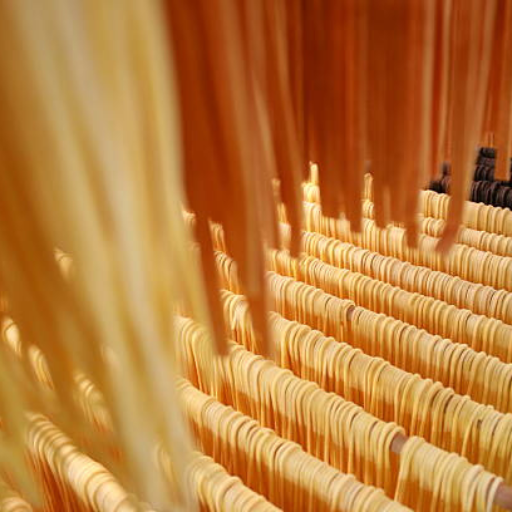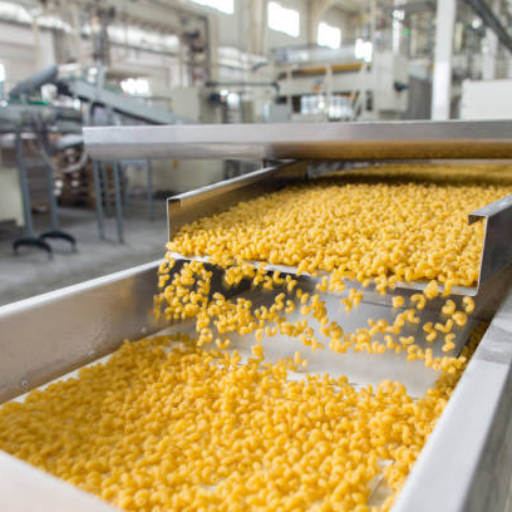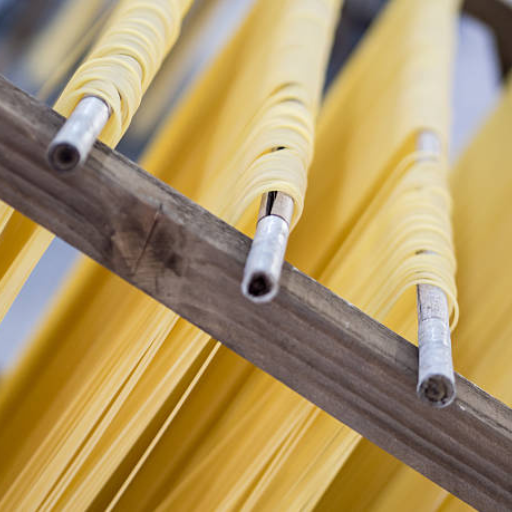Pasta, a staple in diets around the world, owes much of its widespread popularity to the efficiency and scale of modern production facilities. One such facility stands out as the world’s largest pasta factory, operating at an immense scale to meet global demand. In this article, we delve into the fascinating processes and technologies that enable this colossal factory to produce tons of pasta daily. From the careful selection of raw ingredients to the meticulous quality control measures, we explore every stage of production. Join us as we uncover the secrets behind the production lines, the innovations driving efficiency, and the dedication to maintaining the highest standards of taste and quality. Whether you’re an avid pasta lover or interested in industrial food production, this journey through the world’s biggest pasta factory is sure to be an enlightening experience.
What Is the Commercial Pasta Production Process?
Understanding Pasta Production Stages
The process of commercializing pasta has several stages that begin with the selection of top quality durum wheat semolina. After that, the semolina is combined with water to form dough, and this dough is shaped using different pasta molds and dies by kneading. The shaped ones are then dried in a controlled environment to retain excellent texture as well as shelf life. Finally, strict checks are carried out on the dried one before being packaged and exported all over the world. Each step is carefully observed to ensure high quality and consistency.
The Role of Pasta Machines in Production
Pasta machines are essential in industrial pasta making since they automate and facilitate various steps of processing. Ordinarily, this includes a mixing machine which does a good job of blending durum wheat semolina together with water for uniformity in dough making. Such dough is passed through extruders with specially made moulds and dies that shape it into different forms including spaghetti, macaroni or anything more complicated such as fusilli or farfalle.
After extrusion comes drying where the product undergoes specific temperature and humidity conditions generally managed by advanced drying systems to achieve an appropriate texture containing moisture levels for long shelf life purposes. In order to maintain efficiency and consistency, modern pasta plants use state-of-the-art technology like continuous drying lines or automatic quality control systems. Lastly, packaging machines take care of these formats so that the pasta can be distributed globally while maintaining strict hygienic practices.
Insights into Pasta Quality Control
Quality control measures in pasta production play a significant role in ensuring that consumers get what they want: deliciousness, uniformity and safety. Some important measures undertaken by leading manufacturers include:
- Raw Material Assessment: Initial stage involves thorough checking of basic materials used which mostly includes durum wheat semolina as well as water mainly inspected for granulation, coloration including gluten content in flour check will assure consistent elasticity.
- In-Process Monitoring: Continuous monitoring and control play a crucial role at every stage of production. These include hydration levels of the dough during mixing, extrusion pressure and temperature as well as final moisture content after drying. For instance, advanced sensors and automated systems help in maintaining these parameters within prescribed limits.
- End-Product Evaluation: The final product is extensively tested for its appearance, texture and cooking properties. Instrumental tests such as gluten index, coloration or cooking loss along with sensory assessments like taste testing or texture analysis are used to qualify it before being consumed by customers.
These strict quality controls enable pasta manufacturers to produce superior pasta consistently that will meet the needs of consumers who expect nothing but great tasting pasta meals.
How Is Fresh Pasta Different from Dry Pasta?
Production Process for Fresh Pasta
As opposed to dry pasta, the production process of fresh pasta has a few distinct steps. First, fresh pasta dough is typically made using flour and eggs together with other ingredients that give it a richer taste and softer texture. The mixture of ingredients should be stirred until it forms into a smooth elastic dough. After mixing, fresh pasta is rolled out immediately while dry one undergoes a long drying period. Later on the freshly mixed paste is cut or shaped depending on the type of pasta desired.
Fresh pasta contains more moisture content so that it is soft in nature; this makes it cook faster compared to other types particularly within minutes whereas dry takes longer time to cook. In addition, since fresh pasta does not involve drying phase, it is often prepared in small amounts and has short shelf life hence requiring refrigeration or immediate use to maintain its quality.
This creates a different culinary experience because of its distinctive taste and texture as we keep these production specifics for fresh pastas compared to their dried counterparts.
Drying Process For Dry Pasta
The drying process for dry pasta has been meticulously designed to increase its shelf life thus making it less perishable. Once dough is prepared, it can be either extruded or rolled into required shapes. The next stage involves drying which takes place by putting the formed pasta into chambers set with certain temperatures and levels of humidity control in order to remove moisture from the food products slowly but surely until they are completely dry over varying periods ranging from several hours up to days according to size and thickness of each type. Drying properly ensures that microbial growth does not occur and that the shape is maintained when cooking the dried product. This extensive drying method allows storage without refrigeration for many months making dried pastas an important food item found in many homes world wide.
Shelf Life And Storage Conditions
In comparison between fresh and dry pastas, the latter have a longer shelf life because of thoroughness in the drying process. When kept in a cool dry place away from direct sunlight and moisture, dry pasta can maintain its quality for up to two years. The packaging has a significant impact on retaining its freshness thus ensuring that it remains in its original air-tight package or decanted into an air-tight container.
On the other hand, fresh pasta lasts for about three days and should be keep refrigerated to maintain their taste and texture at their best. If you need to prolong the shelf life of fresh pasta then freezing is an option you can consider. Fresh pasta could be stored for up to eight months with no big loss of quality if placed into hermetic containers or freezer-safe bags before putting them in the freezer.
Thus, by observing these storage guidelines, both fresh and dry pastas will last long without loss of taste making them suitable for your cooking needs as well as being safe food products.
What Ingredients Are Essential for High-Quality Pasta?
The Importance of Durum Wheat to Pasta Production
Durum wheat is a key ingredient in the production of excellent quality pasta because it has a number of unique qualities. A hard type of wheat, durum contains more protein than ordinary wheat, especially gluten, which makes pasta firm and elastic. When cooked, this gluten network traps air and water to give it an al dente texture. In addition, durum wheat provides a rich golden color for the pasta that enhances its aesthetic appeal. Besides, semolina (milled form) being coarse textured helps bind dough together hence making pastas hold sauce better. Therefore, by using durum wheat they can ensure that pasta is always highly regarded befitting culinary and consumer expectations.
How Flours Influence Pasta Dough
Even though Semolina flour and regular flour are quite different from each other; their effect on pasta dough is complementary in nature. Semolina made from hard durum wheat has a rough texture and high content of glutens which contribute to firmness and flexibility of dough. This yields desired al dente bite characteristic combined with yellowish shade in one’s pasta dish or visually attractive ‘golden’ look. All-purpose flour is finer ground with fewer proteins hence appropriate for softer pastas on the other hand. Incorporation of these two ingredients will create well balanced dough which can be shaped easily and also holds sauces perfectly when cooked as raw noodles. During cooking process use semolina so that your paste does not fall apart while all purpose flour could tenderize the paste eventually; therefore both materials combine well to produce superior quality pastas meeting varying needs of culinary art.
Other Essential Ingredients for Different Pasta Varieties
Some components apart from semolina flour or plain flour play vital roles toward coming up with varieties of pasta dishes among others are discussed hereunder: Eggs are often used as part of the ingredients to improve taste as well as texture through added fat or proteins into your doughs during pasta making. A good example is egg pasta such as tagliatelle and pappardelle that need high amounts of eggs to obtain the creamy, smooth texture.
When it comes to eggless like orecchiette or trofie, water becomes a necessary item that hydrates dough. Others even include olive oil in their doughs so as to make them slippery thus preventing pastas from drying up.
Sometimes, flavors may be added to the color of the pasta; this is where spinach, tomato and squid ink are used. Spinach provides green color while adding a subtle earthy flavor into the dough and tomato paste gets you red hue along with some sweetness. Squid ink gives black coloring and a salty taste which is ideal for Italian seafood dishes.
Lastly, salt is sometimes included in the dough for enhancing its taste but it’s more common practice to season cooking water heavily during boiling process. Some recipes also call for herbs such as basil or oregano while others go ahead and use saffron among other spices giving distinctive tastes that work well with different sauces including fillings depending on what one wants out of his food. With these added ingredients at hand, there is no limit to what one can achieve especially considering that they are very flexible hence can be used with basic ones according personal preferences thereby providing room for additional creativity in terms of taste being unique for every particular dish required by diverse people around the world interested in trying new things in life; this also helps cater different cultures more specifically those who love Italian cuisine!
Which Machines Are Used in the Biggest Pasta Factories?
Overview on Pasta Production Line
Modern pasta production lines in the largest factories consist of many efficient machines collaborating with one another to ensure mass production is done effectively. Primary stages include mixing, extruding, drying and packaging.
- Mixing Machines: The process commences with mixing machines that combine semolina flour with water (and, if required eggs) to create a dough that has uniform consistency. These mixers ensure all ingredients are evenly mixed so as to have the texture that is desired.
- Extruders: Next, the extruders shape the dough into various forms of pasta. Different types of dies in extrusion machines can be used for making different shapes such as spaghetti or penne. Therefore, the extruded pasta is cut to size it needs.
- Drying Machines: Once shaped, pasta must be dried in order to reduce its moisture content and extend shelf life. Controlled environment drying towers are used where the pasta dries slowly under adjustable temperature and humidity conditions. This stage helps prevent spoilage and maintain structure of the paste.
- Packaging Machines: The last point at which handling can be done on dry pastas is when they reach packaging line. After weighing them using packaging machine, there are put into bags or boxes which are sealed for long lasting freshness. Besides putting labels on packages other activities like checking quality have also been included in modern packaging systems for consistency purposes and compliance to industry requirements.
These machines work together seamlessly transforming raw materials into finished products ready for distribution worldwide in markets everywhere. Automation integrated with precision technology allows high-volume production of top-quality pastas.
How Extruders Shape Pasta Dough
Extruders and sheeters play a major role in shaping pasta dough during processing into desired forms.
- Extruders: Extrusion systems have dies that determine how pasta will look when shaped by these machines. High-pressure pushes dough through specified dies forming specific shapes of different pastas. Each type of pasta design, such as spaghetti or macaroni, requires its own die. Through extrusion the pressure creates uniformity and consistency of shapes so essential for appropriate cooking qualities and good looks.
- Sheeters: Contrary, sheeters are preferred in turning dough into thin sheets that can be then cut into different shapes and sizes like lasagna or ravioli. It is passed through rollers on a sheeter to flatten it at a wanted thickness. The sheeted dough must pass through various cutters after rolling; this will churn out numerous forms of pasta since the need may arise. Sheeters, therefore, are highly recommended for making flat shaped pasta varieties as well as filled pasta types.
These two machines –extruders and sheeters– enable producers to make many different types of pastas cost-effectively with high accuracy thus ensuring consistent quality over extensive production runs.
Role Played by High Temperature and Low Temperature Processes
In pasta manufacturing, process temperatures play significant roles concerning final product quality and characteristics of each kind of pasta being produced.
Drying at high temperatures
High temperature drying is a method of quickly reducing the amount of moisture in pasta. In this case, pasta is ex posed to 70°C-90°C heat only for a short time, which maintains its structure and reduces drying time. The process also hampers microbial growth; thus making the food safe and increasing shelf life. This method is widely used for dry pasta varieties so as to maintain even drying thereby preserving the texture and quality.
Drying at low temperatures
On the other hand, low temperature drying involves slow drying of pasta under low temperatures (generally below 60°C). This traditional practice is more gentle on pasta, allowing it to retain most of its flavors and scents. Low temperature drying suits artisanal pastas that have more emphasis on quality rather than quantity. This procedure provides an enjoyable culinary experience with well-cooked pasta that has a pleasant al dente feel.
It is important to note that both high temperature and low temperature processes are crucial in the manufacture of various types of pastas hence meeting different tastes and demands in the market by customers.
What Are the Challenges in Commercial Pasta Manufacturing?
Sustaining the same taste and quality of pasta
Keeping up with the same unchanging taste and quality in commercial pasta manufacturing is a complicated task that requires careful attention throughout all phases of production. In my own experience, ensuring this constancy starts with choosing semolina flour of excellent quality, as the main ingredient significantly affects final product’s flavor and texture. Moreover, it is important to control moisture content of dough and to mix it uniformly so as to avoid air holes or abnormal shapes.Moreover, accurate temperature regulation during high-temperature drying (above 120°C)and low temperature drying below 70°C allows for achieving desired pasta characteristics and expanding shelf life.Well also; constant checks on quality standards as well as observing very strict hygiene aids in ensuring that any given set has met what was expected thus providing consumers with reliable products.
Optimal Drying Cycles And Process Conditions
Optimizing drying cycles and process conditions in commercial pasta manufacture involves addressing a number of competing concerns around product quality and efficiency. My experience suggests that it is important to closely monitor drying process temperatures and relative humidity. Keeping airflow even throughout and ensuring that moisture content drops slowly are essential for avoiding cracks on the surface while making sure that the internal structure remains sound.The third one may involve determining exact drying duration depending upon paste shape or size to ensure uniformity at every piece made while keeping appropriate flavors or textures intact.Modern monitoring technologies often allow dynamic adjustments during processing which reduces lot-to-lot non-conformances enhancing production consistency overall.
Cooking Loss Reduction in Final Products
From my researches conducted based on professional experiences, reducing cooking loss in pasta products mainly focuses on strengthening protein network of doughs as well as optimizing hydration levels. Use of semolina flour rich is protein can be instrumental in improving cooking stability hence reducing solid materials lost into cooking water.In addition; careful control over pasta extrusion process together with drying helps form a denser product resistant to breakages during cooking.These measures essentially lead to a more standardized and high-quality final product that meets the requirements of the industry as well as expectations from customers.
Frequently Asked Questions (FAQs)
Q: Why is pasta drying an important step in the production of fresh pasta?
A: Pasta drying process is crucial because it removes extra moisture, thus no chance for microbial growth and further extending of the shelf life. To guarantee high quality, control needs to be made on factors such as temperature and relative humidity.
Q: What role does the Maillard reaction play in pasta production?
A: The Maillard reaction, which is a nonenzymatic browning reaction between amino acids and reducing sugars that gives browned food its distinctive flavor. Moreover, it can also occur during drying of pasta, which leads to formation of compounds that enhance its sensory attributes.
Q: How does commercial pasta production maintain product quality and consistency?
A: Consistency and maintaining product quality in commercial pasta production consist of use state-of-the-art equipments, controlling drying conditions while extruding precision should be maintained during the process of making dough for pasta. Similar activities are carried out repeatedly to ascertain other qualities like appearance among others when they are still within tolerance limits.
Q: What are the advantages of using state-of-the-art machines in pasta production?
A: State-of-the-art machines used in making pastas have many benefits such as improved efficiency, consistent product quality, less waste and higher capacities. In most cases these machines come with advanced technology which ensures accurate monitoring through entire manufacturing process.
Q: What types of pasta can be produced at an industrial level?
A: At an industrial level a variety of pastas inclusive short ones like penne or rigatoni as well as long ones like spaghetti or fettuccini can be produced. For different shapes various dies or extrusion cylinders are formed.
Q: How is the quality of pasta measured in a commercial setting?
A:The quality control set up in a commercial setting involves putting into consideration multiple factors ranging from texture to cooking properties as well taste. It is done by sensory assessment involving starch granules examination, total organic matter content measurement and other tests.



















